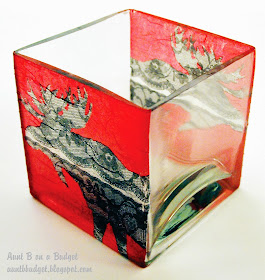I make muffins almost every weekend, and put them in the freezer so that we can enjoy them for breakfast or lunch throughout the week.
There are an almost endless variety of muffin recipes available on line but I often make mine up as I go along, based upon the ingredients I have on hand. That's how this recipe came to be. I wanted to make something a little bit different, using ingredients I had in the pantry.
I pulled a jar of homemade peach pie filling from the shelf and built around it. The resulting muffin was very moist (always nice in a bran muffin, I think), with a pleasant gingerbread-y flavour from the spices. We enjoyed them warm from the oven with just a little butter. When they were cooled, we served them with cream cheese. Both were yummy.
To make Peach Spice Bran Muffins, you'll need:
- 1 pint canned peaches or peach pie filling (I used homemade pie filling this time. Canned or jarred peaches or pie filling from the store will work just fine too.)
- 1 egg
- 1-1/2 cups wheat bran
- 1/3 cup sunflower oil
- 2/3 cup brown sugar
- 1 cup flour
- 1 teaspoon baking soda
- 1 teaspoon baking powder
- 1 teaspoon cinnamon
- 1 teaspoon ground ginger
- 1/2 teaspoon salt
Begin by preparing the peaches. If you're using canned peaches, pulse them in your food processor until the pieces are chopped but still have some texture. Remove about half the chopped fruit and then process the remainder into a puree. Transfer both the peach pieces and the puree to a large bowl.
If you're using pie filling, process it just until the pieces are chopped but still have some texture, then transfer it to your bowl.
Beat the egg and add it to the pie filling, along with the bran, oil, and brown sugar. Stir until well combined.
Set the mixture aside and let it rest for 10 minutes.
In a separate bowl, whisk together the flour, baking soda, baking powder, cinnamon, ginger, and salt.
Add the flour mixture into the wet mixture and stir just until combined. The batter will be quite thick and a little lumpy.
Portion the batter into an oiled muffin pan. These muffins don't rise very much, so fill the cups of the muffin pan quite full.
Depending upon how much batter you spoon into each cup, you'll get between ten and twelve muffins. I got eleven from this batch.
Pour a small quantity of water into any empty cups in the pan. This will help distribute the heat more evenly and also protect the pan from warping.
Bake the muffins on the middle rack of a 350F oven, for about 25 minutes, until they spring back when you press on the centre lightly with your fingertip.
Allow the muffins to cool 10 minutes in the pan, then transfer them to a wire rack to cool completely.
Store the muffins in an airtight container for up to 3 days, or freeze them and thaw them as needed.



















































